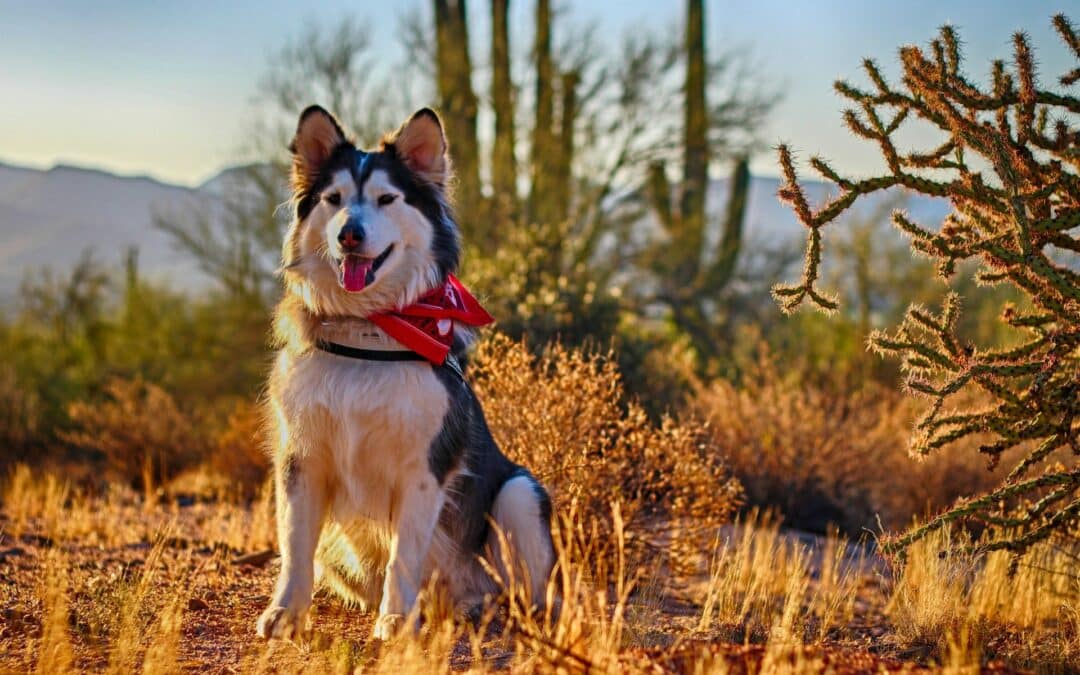Arizona’s stunning desert landscapes and sunny skies make for incredible hikes, but they also come with serious risks, especially for your dog. Hot pavement, prickly plants, and hidden critters can turn an afternoon of adventure into an emergency if you’re not prepared.
Here’s what to do before you hit the trail with your dog in Arizona.
1. Check the Weather
What temperature is too hot for your dog to hike? Dogs can get overheated quickly. As a general rule, anything over 85°F is borderline. If it’s over 90°F, skip the hike and stay inside or head to higher altitudes where it’s cooler.
Dogs don’t sweat like we do. They cool off by panting and release heat through their paw pads. When outdoor temperatures climb, the risk of heatstroke, burned paws, and dehydration rises quickly.
Plan your hikes for early in the morning or close to sunset, and always check the ground temperature. If you can’t hold your hand on the pavement for five seconds, it’s too hot outside for your dog.
2. Pack for Your Pup
Protecting your dog on a hike starts with being prepared. Before you leave the house, make sure you’ve packed all the essentials.
Here’s what you’ll need:
- A collapsible water bowl
- Fresh, cool water
- Dog-safe trail snacks
- Dog booties or paw balm (for rough or hot terrain)
- A leash
- Poop bags
- Tweezers or a tick remover
- Pet-safe wipes for post-hike cleanup
Bonus tip: Soak a small towel in cold water and seal it in a plastic bag—it makes a great quick cool-down tool for both you and your pup.
3. Protect Against Ticks and Critters
Ticks may not be as common in Arizona as in other areas, but they’re still out there, especially in wooded or grassy areas. And ticks aren’t the only concern.
Scorpions, snakes, and cactus spines are also common trail hazards. A curious nose or paw in the wrong place could result in stings, bites, or painful injuries.
To help protect your dog:
- Use vet-approved flea and tick prevention all year round
- Stick to wide, well-maintained trails, and keep your dog out of bushes or rock piles
- Carry wipes and tweezers to remove debris on the go
- After the hike, check your dog thoroughly for ticks, thorns, spines, or irritation
If your dog gets stung, bitten, or starts limping, panting, or licking a specific spot excessively, contact your vet right away. Some encounters (especially with venomous snakes or scorpions) may require emergency care.
4. Keep Your Dog on a Leash
We know that all dogs love to explore, but off-leash hikes come with big risks. From overheating and injuries to dangerous wildlife like javelinas or rattlesnakes, keeping your dog on a leash is always the safest choice.
If your dog needs off-leash time, stick to fenced dog parks or designated off-leash areas where it’s safer to explore.
5. Watch for Signs of Overheating
Even if your dog seems fine, they may be overheating. Keep an eye out for signs like:
- Heavy panting
- Bright red gums or tongue
- Glazed eyes
- Wobbling or slowing down
- Vomiting or diarrhea
If you notice any of these symptoms, move your dog to a shaded area, offer water, and call your vet. In severe cases, overheating can be life-threatening.
6. Clean Up and Cool Down
When you get home, check your dog’s paws for cuts, cactus spines, thorns, or burns. Give them a gentle rinse or wipe-down to remove dust, pollen, or plant oils. Offer plenty of water and let them rest in the A/C for the rest of the day.
And don’t forget—dogs need recovery time, too. Skip the hike the next day and go for a short walk or some indoor play instead.
Planning a Hike with Your Dog?
Hiking in Arizona can be a fun and rewarding bonding experience, but you do need to make sure that your dog is trail-ready. At Anasazi Animal Clinic, we can help with personalized advice, flea and tick prevention, and overall wellness care.
Contact us today to schedule a checkup or talk about the best outdoor safety strategies for your dog.
Photo by Daniel Tuttle on Unsplash used with permission under the creative commons license for commercial use 7/17/2025

